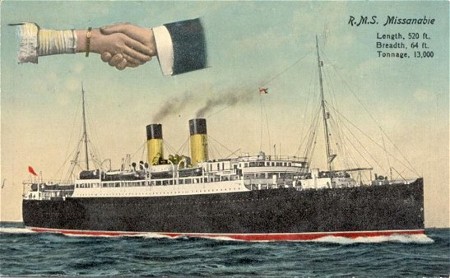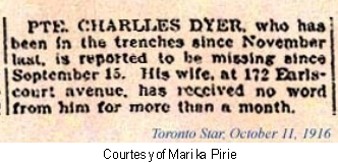|
Sep 25, 1892
|
Born in St. Albans, Hertfordshire, England to
Charles D. and Rhoda (nee Hale) Dyer
|
|
Aug 2, 1909
|
Married to Rose Henrietta Atkins in Buffalo, New
York, USA
|
|
Feb 23, 1915
|
Attested into the 39th Battalion in
Port Hope, Ontario
Ø Number 412569
Ø Next of kin given as Rhoda Childs, mother, 132 Boon Ave., Toronto,
Ontario
o He also reported that he was married to Mrs. Rose Dyer, 172 Earlscourt
Ave., Toronto
Ø Previous occupation given as Teamster
Ø No previous military experience given
Ø Religion given as Wesleyan
Ø Assigned to “B” Company
The battalion trained in the Belleville, Ontario
area
|
|
Apr 9, 1915
|
Forfeited 7 days pay for an unspecified offence
|
|
May 27, 1915
|
Sentenced to 5 days detention and loss of 5 days
pay for an unspecified offence
|
|
Jun 17, 1915
|
Embarked the SS Missanabie in Montreal, Quebec

|
|
Jul 3, 1915
|
Disembarked in Plymouth, England and proceeded
to Shorncliffe and then on to Lydd to continue training
|
|
Aug 5, 1915
|
Forfeited 2 days pay and sentenced to 4 days
Field Punishment #2 for an unspecified offence
|
|
Aug 25, 1915
|
Admitted to the St. Martin’s Plain Tent
Hospital with a diagnosis that reads VDG (Venereal Disease Gonorrhea)
|
|
Sep 24, 1915
|
The 39th Battalion moved to West
Sandling to continue training
|
|
Sep 29, 1915
|
Discharged to unit from hospital
|
|
Oct 8, 1915
|
Forfeited 6 days pay and sentenced to 6 days
Field Punishment #2 for an unspecified offence
|
|
Oct 27, 1915
|
Admitted to the Moore Barracks Hospital in
Shorncliffe with a diagnosis that reads Scabies
|
|
Nov 17, 1915
|
Discharged to duty from hospital
|
|
Nov 24, 1915
|
Transferred to the 21st Battalion
|
|
Nov 25, 1915
|
Arrived at the CBD (Canadian Base Depot) in the
Rouelles Camp, Havre, France as part of a draft of 272 reinforcements from England and TOS
(Taken On Strength) the 21st Battalion
|
|
Nov 27, 1915
|
Left the CBD to join the battalion
|
|
Nov 30, 1915
|
Joined the 21st Battalion in the N
& O trenches near Ridgewood
|
|
Feb 15, 1916
|
Attached to the Canadian Railway Construction
Company for duty
|
|
Feb 22, 1916
|
Admitted to the No. 5 CFA (Canadian Field
Ambulance) Rest Station with a diagnosis that reads Pharyngitis (an inflammation of the
throat)
|
|
Feb 28, 1916
|
Discharged to duty from the rest station
|
|
Mar 16, 1916
|
Admitted to the No 5 CFA with a diagnosis that
reads Tonsillitis and was transferred the same day to the No. 1 CCS (Casualty Clearing
Station)
|
|
Mar 23, 1916
|
Transferred to the No. 6 CFA Rest Station and
the diagnosis was changed to read PUO (Pyrexia of Unknown Origin) which is a fever without
a known cause
|
|
Mar 24, 1916
|
Transferred via the No. 5 AT (Ambulance Train)
and admitted to the No. 2 Canadian Stationary Hospital in Le Treport with a diagnosis that
reads Influenza
|
|
Apr 14, 1916
|
Surgery performed to remove his tonsils
|
|
Apr 20, 1916
|
Ceased to be attached to the railway
construction company
|
|
May 2, 1916
|
Transferred to the No. 1 Convalescent Depot in
Boulogne to continue his recovery
|
|
May 12, 1916
|
Sentenced to 10 days Field Punishment #1 for
stating a falsehood to an NCO and breaking out of camp
|
|
May 22, 1916
|
Discharged to base details for light duties from
the hospital
|
|
May 28, 1916
|
Proceeded to join the battalion
|
|
Jun 1, 1916
|
Rejoined the 21st Battalion in the
“A” Camp near Dikkebus, Belgium
|
|
Sep 15, 1916
|
During the Battle of the Somme, the 21st
Battalion’s objective was a sugar refinery on the Albert-Bapaume Road, near
Courcelette, France. It was strongly defended
by the German army and the battalion suffered many casualties. Private Charles Dyer was first reported missing
during that action, but his body was later recovered and buried in a nearby field. At the end of the war an attempt was made to
exhume his body and relocate him to a proper cemetery.
His remains could not be found and as a result, he is honoured on the Canadian
National Vimy Memorial, Vimy Ridge, France. At
one point in time there was an unofficial report that he had been taken prisoner, but that
proved to be false.

Following the war the 1914-15 Star, British War
Medal, Victory Medal, Plaque (Dead Man’s Penny), Scroll and Memorial Cross were sent
to his widow, Mrs. Rose Dyer, 172 Earlscourt Ave., Toronto, Ontario
A second Memorial Cross was sent to his mother,
Mrs. G. Childs, 203 Sackville St., Toronto, Ontario
|
|

